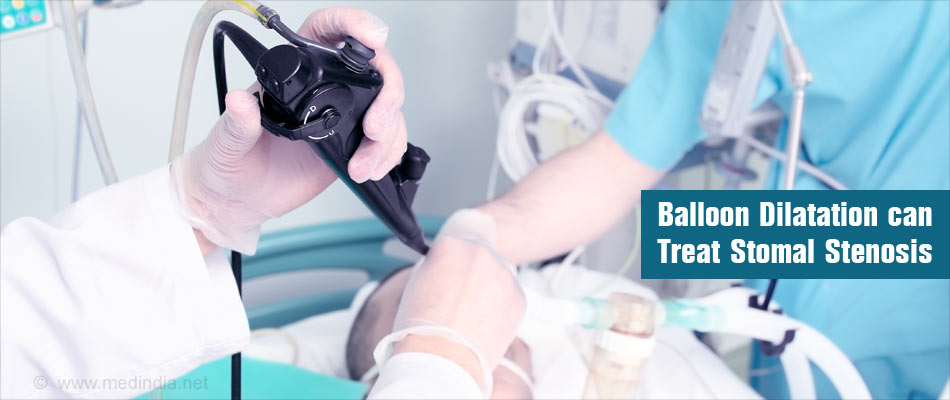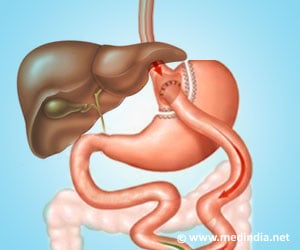- Gastrointestinal Complications After Bariatric Surgery - (http://www.ncbi.nlm.nih.gov/pmc/articles/pmc4843041/)
- Stenosis in gastric bypass: Endoscopic management - (http://www.ncbi.nlm.nih.gov/pmc/articles/pmc3399006/)
- Gastrojejunal anastomotic strictures following laparoscopic Roux-en-Y gastric bypass surgery: analysis of 1291 patients - (http://www.ncbi.nlm.nih.gov/pubmed/16925329)
What is Stomal Stenosis?
A narrowing of the junction between the stomach and the lower intestine of patients after Roux-en-Y Gastric Bypass surgery is known as stomal stenosis.
It is a common complication of gastric bypass surgery and is also known as anastomotic stenosis.

Gastric Bypass Surgery
Changing lifestyles have led to an increase in the incidence of obesity. Excessive obesity gradually interferes with daily activities such as walking and breathing and leads to a deterioration in the quality of life. It is also increases the risk of medical problems like diabetes, hypertension, heart disease, bone and joint ailments.
Weight loss surgery or bariatric surgery is gaining popularity as the treatment of choice for morbid obesity. A laparoscopic method of surgery is the Roux-en-Y gastric bypass surgery. In this surgery, a small part of the patient’s stomach is converted into a pouch by stapling it and is directly joined to the jejunum, thereby bypassing the remainder of the stomach and the duodenum. This results in a reduced capacity of the stomach and the patient therefore eats less. It also reduces the absorption of calories and nutrients from the food eaten. Both the factors together lead to weight loss which signifanctly improves the quality of the patient’s life.
This surgery can be performed as an open surgery or a laparoscopic surgery, though the laparoscopic method is usually preferred. One of the complications that may occur after this surgery is the narrowing of the newly formed junction between the stomach and the intestine, known as stomal stenosis.
What are the Causes of Stomal Stenosis following Gastric Bypass Surgery?
Stomal stenosis occurs when there is a narrowing at the new junction that is formed between the patient’s stomach and intestine following the gastric bypass surgery. The cause hasn’t been proven scientifically, however it is thought to occur due to multiple factors that involve scar formation at the site or a reduction of blood supply (ischemia) in the region around the staple line. An increased incidence has been observed in patients:
- Who smoke.

- Take NSAIDS (Non-Steroidal Anti-inflammatory Drugs) or aspirin.
- Suffer from peptic ulcer disease.
- In whom anastomosis (surgical connection) was done with the help of a circular stapler.
What are the Symptoms of Stomal Stenosis following Gastric Bypass Surgery?
Stomal stenosis usually presents as a late complication of the surgery, around 50 days after the procedure, when the patient makes the transition from soft food to solid food. The symptoms may be:
- Nausea
- Persistent vomiting
- Dysphagia (difficulty in swallowing).
- Food intolerance
- Abdominal pain after eating

How is Stomal Stenosis following Gastric Bypass Surgery Diagnosed?
A suspicion of stomal stenosis arises when a patient demonstrates the mentioned symptoms in the late post-operative period. However, to establish a diagnosis, endoscopy must be done. An endoscopy will also help in ruling out other medical conditions that may cause similar symptoms. Radiological studies with a contrast may be helpful in diagnosing associated leaks.
How is Stomal Stenosis following Gastric Bypass Surgery Treated?
There are two options for treatment or stomal stenosis: endoscopic dilatation and surgical.
- Surgical treatment- In extremely rare cases where endoscopic dilatation fails to yield any result after multiple attempts, surgical revision may be needed in order to treat stomal stenosis.
- Endoscopic dilatation- Balloon dilatation is an effective method of treating stomal stenosis. Balloon catheters are passed through the endoscope and dilated with the help of water, saline or a water-soluble contrast medium at the level of the narrowing. This method allows dilatation under direct visualization with the help of the endoscope. A vast majority of patients are successfully treated with 1-2 dilatations. This technique is safe and avoids surgical intervention.

Prevention of Stomal Stenosis following Gastric Bypass Surgery
The exact cause of stomal stenosis is unknown but as it has been found to occur more commonly in cases where a circular stapler is used, more and more surgeons are resorting to linear staplers of appropriate size.
The patient, on the other hand, may also help in avoiding the complication by:
- Strictly following the doctor’s instructions after the surgery.
- Refraining from smoking.
- Not taking any medication without the doctor’s prescription and knowledge.
Health Tips
- Go for regular follow ups.
- Refrain from smoking.
- Discuss the use of medications like aspirin and anti-inflammatory drugs with your doctor before taking them.
- Maintain a healthy lifestyle post-surgery.
- Look out for the mentioned symptoms and immediately report to your doctor if you notice them.
- Follow the diet schedule prescribed by your doctor.









